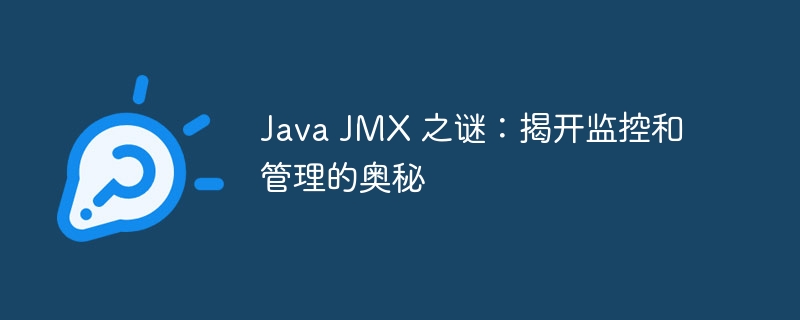Home >Java >javaTutorial >The Mystery of Java JMX: Uncovering the Mysteries of Monitoring and Management
The Mystery of Java JMX: Uncovering the Mysteries of Monitoring and Management
- PHPzforward
- 2024-02-20 21:06:06844browse

Java JMX technology, as the core tool for Java monitoring and management, has always been the focus of exploration by Java developers. In the article "The Mystery of Java JMX: Uncovering the Mysteries of Monitoring and Management", PHP editor Apple will give you an in-depth analysis of the principles and applications of JMX technology, uncover the mysteries behind it, and lead readers to explore Java monitoring and management new realm.
Java Management Extensions (JMX) is a specification and a set of api that can be used to remotely monitor and manage Java applications. It provides a standardized framework that enables applications to expose their internal state and operations, enabling deep insights into application runtime behavior.
MBean
MBean (Management Bean) is the core concept in JMX, which represents the manageable part of the application. MBeans have properties (getter and setter methods), operations, and notifications that can be used to obtain application information, control application behavior, and receive event notifications.
MBean Server
MBean Server is a key component of the JMX architecture, which is responsible for managing MBeans. It provides services for registering, deregistering, and finding MBeans. Applications can register their own MBeans or look for other MBeans when needed.
JMX Client
JMX clients are tools that use JMX to interact with applications. It can be a command line tool, a GUI application, or other Java process. The client uses the MBean Server to connect to the target application and obtain MBean information, invoke operations, and receive event notifications through it.
Monitoring Application
JMX can be used to monitor a variety of application metrics, including:
- Application runtime and CPU usage
- Memory usage and garbage collection information
- ThreadsNumber and thread status
- DatabaseConnection pool information
By monitoring these metrics, developers can identify potential performance issues, memory leaks, and thread deadlocks.
Management Application
In addition to monitoring, JMX can also be used to manage Java applications. For example, you can use JMX:
- Change application configuration settings
- Start, stop and restart applications
- Deploying and uninstalling application modules
Troubleshooting Application
JMX can be used to troubleshoot application issues. By obtaining application status information, developers can narrow down the source of the problem, such as:
- Identify memory leaks and performance bottlenecks
- Diagnosing thread deadlocks and exceptions
- Analysis ApplicationLogFile
Code Example
The following code example demonstrates how to use MBean Server to manage MBeans:
MBeanServer mbeanServer = ManagementFactory.getPlatfORMMBeanServer();
ObjectName mbeanName = new ObjectName("com.example:type=MyMBean");
// 注册 MBean
mbeanServer.reGISterMBean(new MyMBean(), mbeanName);
// 获取 MBean 属性值
Object attributeValue = mbeanServer.getAttribute(mbeanName, "myAttribute");
// 调用 MBean 操作
mbeanServer.invoke(mbeanName, "myOperation", null, null);
// 注销 MBean
mbeanServer.unregisterMBean(mbeanName);
in conclusion
Java JMX is a valuable tool for monitoring, managing, and troubleshooting Java applications. By demystifying it, developers can take full advantage of its capabilities and ensure application reliability and performance. Whether solving performance issues or managing complex deployments, JMX provides the necessary insight and control to enable developers to effectively manage their Java ecosystem.
The above is the detailed content of The Mystery of Java JMX: Uncovering the Mysteries of Monitoring and Management. For more information, please follow other related articles on the PHP Chinese website!

